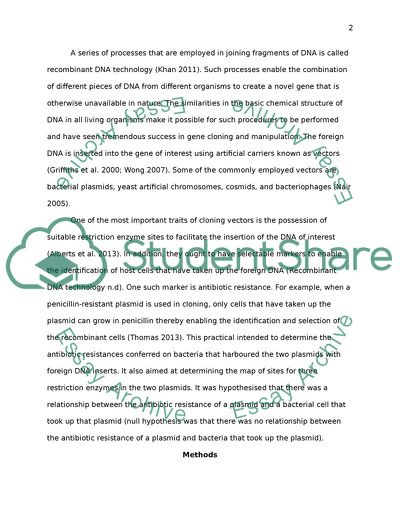Cite this document
(The Determination of Antibiotic Resistance and Restriction Sites in Plasmids in Transformed Bacterial Cells Lab Report Example | Topics and Well Written Essays - 1500 words, n.d.)
The Determination of Antibiotic Resistance and Restriction Sites in Plasmids in Transformed Bacterial Cells Lab Report Example | Topics and Well Written Essays - 1500 words. https://studentshare.org/biology/1813303-give-the-report-a-suitable-title-but-the-report-is-on-plasmid-dna
The Determination of Antibiotic Resistance and Restriction Sites in Plasmids in Transformed Bacterial Cells Lab Report Example | Topics and Well Written Essays - 1500 words. https://studentshare.org/biology/1813303-give-the-report-a-suitable-title-but-the-report-is-on-plasmid-dna
(The Determination of Antibiotic Resistance and Restriction Sites in Plasmids in Transformed Bacterial Cells Lab Report Example | Topics and Well Written Essays - 1500 Words)
The Determination of Antibiotic Resistance and Restriction Sites in Plasmids in Transformed Bacterial Cells Lab Report Example | Topics and Well Written Essays - 1500 Words. https://studentshare.org/biology/1813303-give-the-report-a-suitable-title-but-the-report-is-on-plasmid-dna.
The Determination of Antibiotic Resistance and Restriction Sites in Plasmids in Transformed Bacterial Cells Lab Report Example | Topics and Well Written Essays - 1500 Words. https://studentshare.org/biology/1813303-give-the-report-a-suitable-title-but-the-report-is-on-plasmid-dna.
“The Determination of Antibiotic Resistance and Restriction Sites in Plasmids in Transformed Bacterial Cells Lab Report Example | Topics and Well Written Essays - 1500 Words”. https://studentshare.org/biology/1813303-give-the-report-a-suitable-title-but-the-report-is-on-plasmid-dna.


